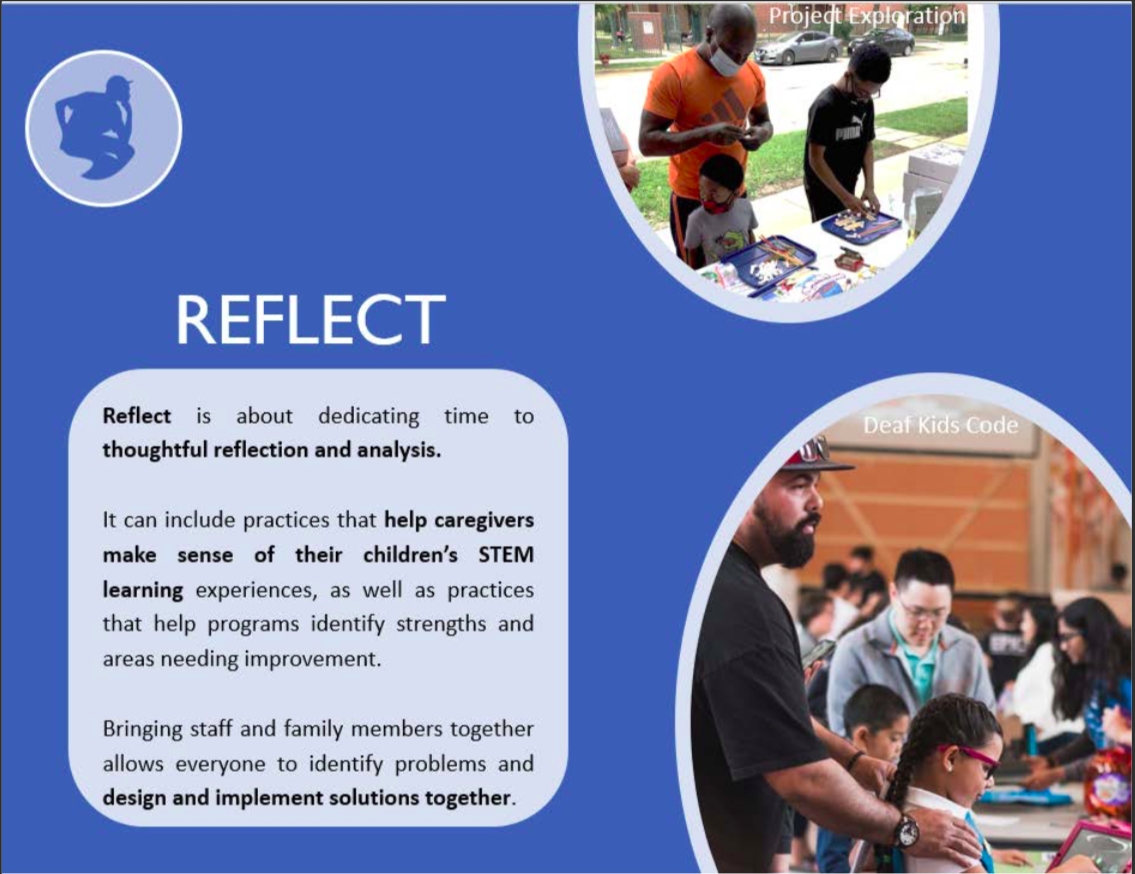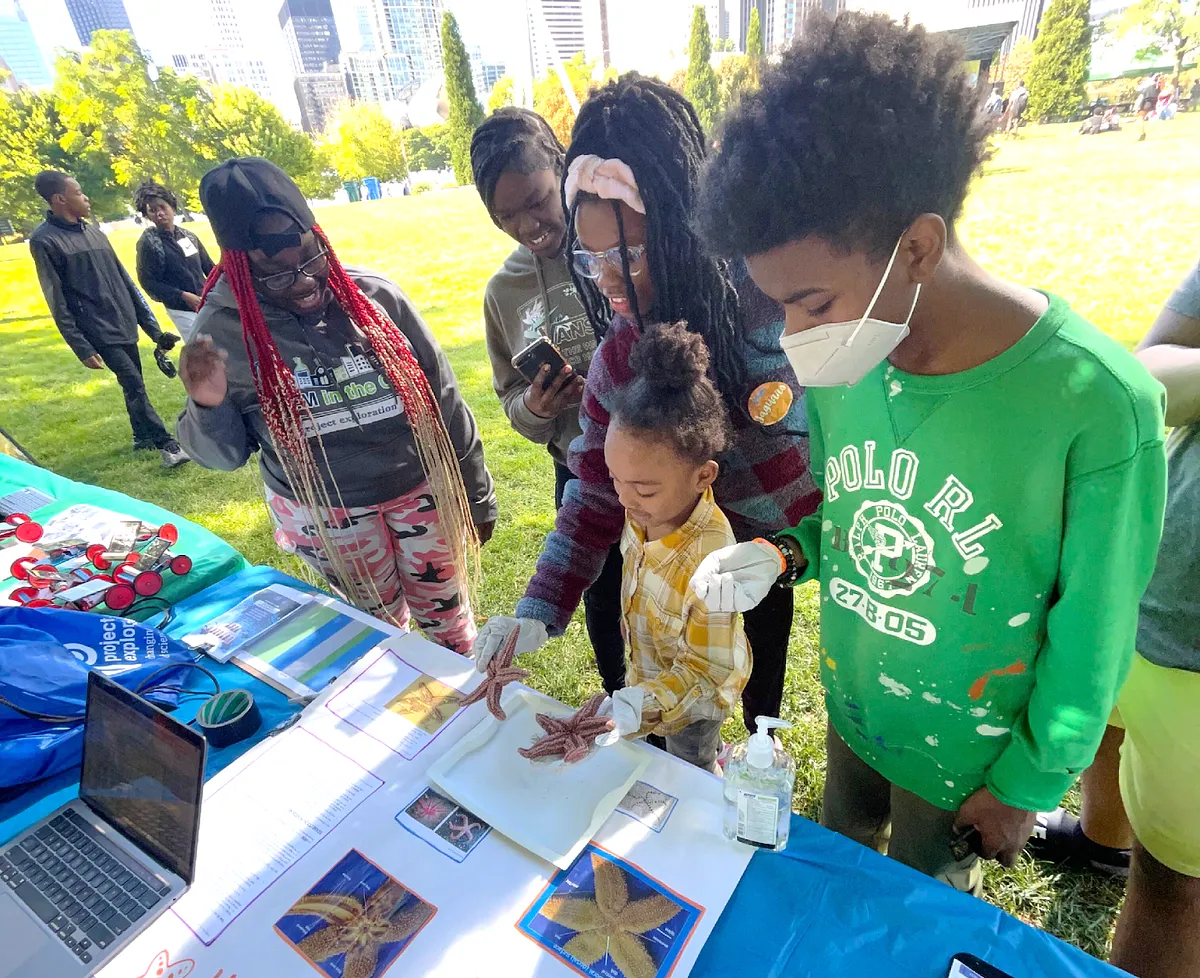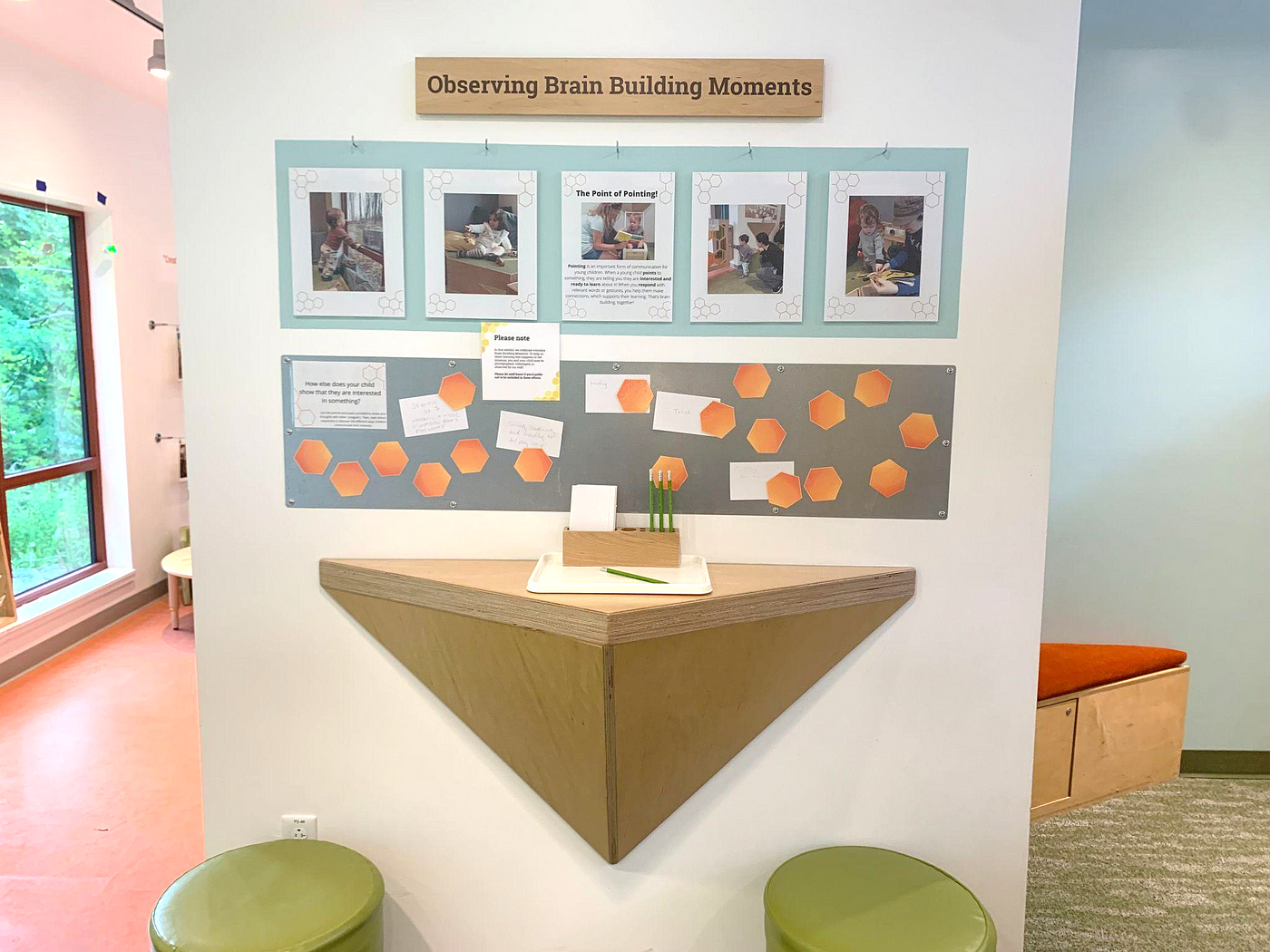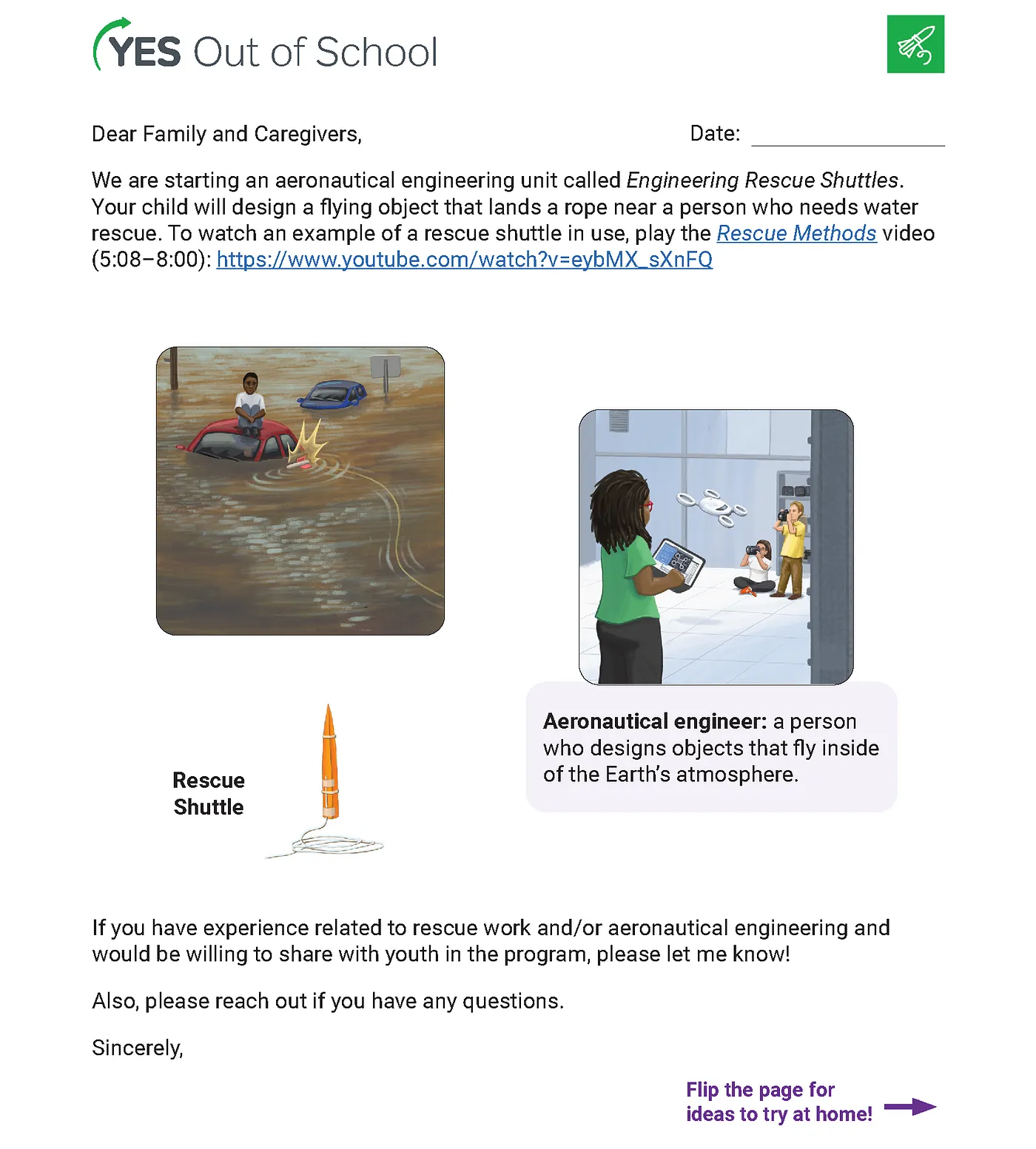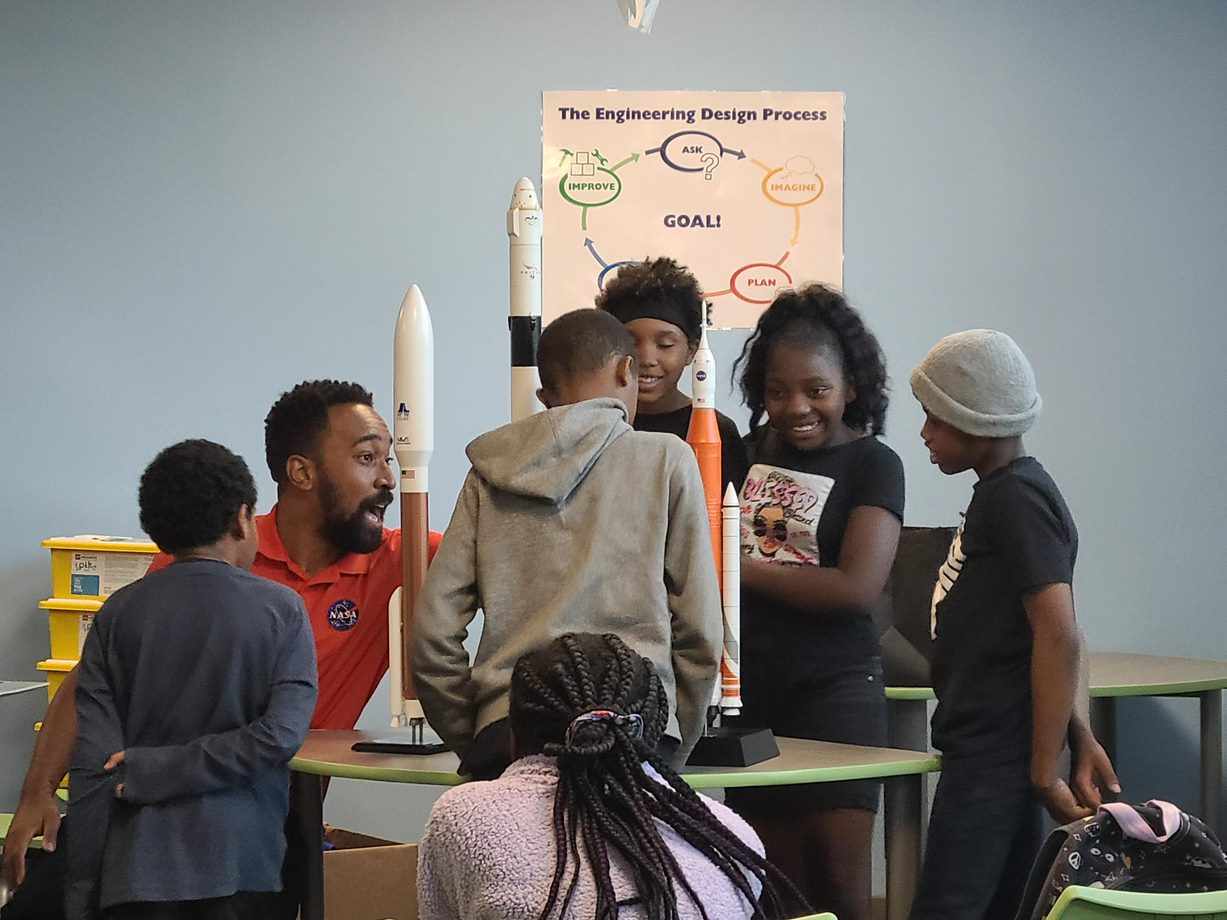STEM Next Opportunity Fund believes passionately in the power of families to inspire our next generation in science, technology, engineering, and math (STEM). When families learn and play together, the possibilities for children to explore new talents are endless. As families cook a favorite recipe, repair a bicycle, or tend a garden, children learn practical lessons in math and science. These opportunities can help inspire a lifelong passion for STEM.
How do we make sure that every family has access to STEM opportunities whether they live in a small town in South Dakota, on a reservation in Montana, in a multigenerational household in New Orleans, or in a tech hub in Silicon Valley? Support for family engagement is essential.
STEM Next supports family engagement through research, resources, and training. This work is guided by STEM Family Engagement: A Planning Tool, which elevates best practices and facilitates professional development for impactful and equitable family engagement. The Planning Tool is organized around the CARE framework: Connect, Act, Reflect, and Empower.
This blog focuses on the “R” for Reflect in the CARE framework. This framework organizes key ideas and strategies used to support and improve the capacity of program staff, families, and youth in STEM learning in out-of-school-time activities.
This blog is the second in the series, Growing STEM Leaders through Family Engagement. We highlight practices from the field for thoughtful reflection and analysis. Personally, our best efforts and bright spots emerge from work that is reflective and constantly in motion. We offer three ideas to help programs build reflection into their DNA to identify strengths and areas for improvement.
1. Reflect with caregivers
Family engagement often takes the form of events that showcase STEM activities at the end of afterschool and summer programs. While these events celebrate STEM and are enjoyed by those who participate, there are many additional opportunities to engage caregivers along the way and deepen their participation.
The STEM Planning Tool and CARE framework offer ideas so that caregivers can reflect on what they are already doing to support their children and how they can take STEM to the next level. This takes the pressure off parents from needing to be the STEM expert to learning with their child. A reflection mindset can also help children to think about what they are learning and see that STEM is all around them.
Reflection with families in action
We love how the following example lifts up reflection. Project Exploration has been offering STEM programs in Chicago, IL for over 20 years. As Project Exploration expanded service to a new community, they sought to expand beyond their usual events to take family engagement to the next level. The Planning Tool and CARE framework gave them the tools to do just that.
Project Exploration empowered staff and families to go beyond doing STEM to making sense of STEM. With this new mission, staff created opportunities for families to make learning more personal and meaningful at home.
During orientation to STEM camp, families learned ideas to support their children in STEM. The big takeaway — you don’t have to be a STEM expert to champion STEM. Importantly, staff offered an idea on how to support their child in this STEM camp. Caregivers were invited to ask their child every day after camp the following questions: “What did you like?” and “What did you learn at camp?”
This example does not require a lot of extra time or resources on the part of staff or caregivers. For more about this work and how to support caregivers in listening and asking questions, read the Program Spotlight of Project Exploration by Patty Allen.
2. Reflect with staff
Like STEM, family engagement requires repeated hands-on practice to build the family engagement “muscle.” However, out-of-school-time leaders and practitioners are likely to have limited training for working with families. They don’t just need to know STEM content. They also need to understand how to support family engagement in STEM. Staff need encouragement to reflect and the tools to try new ways to support family engagement and purposely promote equity and access. Through reflection, staff can create connections between STEM activities in a class or camp and engagement within families at home.
Reflection with staff in action
At the Postcard Project summer camp at the Shaver’s Creek Environmental Center in Pennsylvania, kids were encouraged to share camp highlights with their families. Upon reflection, staff learned that a prompt asking kids to tell what they learned during camp was not effective; kids just named what was in their photo. Instead, the following three prompts sparked rich reflections. 1) My picture is of … 2) Today I learned … and 3) I want to learn more about … Kids’ responses helped parents understand their child’s interests and follow up with relevant conversations and activities. You can read more about the Digital Postcard Maker project in this article in TechTrends by Heather Toomey Zimmerman and Chris Gamrat.
You can read more about the power of reflecting and empowering staff to take action to enhance family engagement in our blog, 2019 The Summer of STEM.
3. Invest in professional development and set the stage for reflection
STEM Next offers professional development with a community of practice that supports family engagement in STEM. This model brings together educators over an extended period to share strategies and resources, reflect on how to overcome barriers that limit access, and plan with partners. For a fuller description of how to plan and host a community of practice, check out our Field Guide: How to Host a Community of Practice.
Professional development and reflection in action
Natacha participated in STEM Next’s Community of Practice on family engagement. Natacha develops curriculum for Youth Engineering Solutions (YES), a preK-12 engineering education initiative and brought back her learnings to her team.
The Planning Tool gave Natacha new ideas to engage families and invite caregivers to reflect on and engage in STEM experiences with their children. The breakout sessions with other participants helped spark “ah ha” moments, providing concrete examples of best practices in family engagement that could be incorporated into the YES curriculum.
Natacha and her team reflected on their goals for family engagement and examined how they could find additional ways to meaningfully engage families. They took a multifaceted approach and developed authentic opportunities in the activities, including a tip for engaging families in every learning unit, giving caregivers a practice they can do at home. Additionally, they conducted focus groups with educators to reflect on how to improve these resources to meet their goals for family engagement.
In writing this blog we reflected on our personal experiences with family engagement and the role that reflection plays in our beliefs and work.
Linda: One of my biggest learnings from reflection is the importance of listening and learning from caregivers. I have learned that I need to listen for barriers and solutions to barriers. At Techbridge Girls, I heard that transportation was a challenge for participation in our summer programs. However, what I thought was a solution — providing free shuttle service for girls — proved unsuccessful. If I had a do-over, I would have listened to parents for their ideas instead of leaping to solutions. Read our blog, Listening: The “Secret Sauce” for Impactful Family Engagement, for more ideas on how listening and reflecting empowers families and improves STEM programs.
Natacha: As I reflect on our array of family resources that was strengthened by our work with STEM Next, I recognize how much we learned from out-of-school educators and program administrators. We carefully listened to educators to understand how well our resources supported them to meaningfully engage families. A pivotal realization for us has been the principle that “less is more.” Providing families with a single, impactful resource, such as an exploration of home safety technologies related to a rescue shuttle design challenge, proves to be more effective than presenting an extensive, potentially overwhelming list of options.
Our takeaway from personal experience within our own families and from decades of work is to consider family engagement not as a destination but as a journey. Your reflections will help you find your way to deeper and more impactful family engagement.
###
Linda Kekelis: I am an advisor on family engagement for STEM Next. I’ve devoted my lifetime to supporting families and educators in encouraging youth in STEM. This work has taken me on a journey and reflection has been at the heart of this adventure. I am grateful to all the families I met over the years who shared their hopes, dreams, and ideas. I am grateful to partners like Natacha who share their experiences and help me better understand the power of reflecting and sharing lessons learned.
Natacha Meyer: I am a STEM Curriculum Manager for the YES initiative at the Museum of Science, Boston. I have worked for over a decade in curriculum development for engineering in grades 1–8. Formerly a life science middle school teacher, learning specialist, and EL administrator, I am passionate about making STEM education accessible and engaging for all. I am so thankful for the collaborative work with the STEM Next community and the ability to disseminate what I have learned with my team.
For STEM Next, family engagement is essential in accomplishing its big new goal of inspiring 20 million more young people with STEM opportunities by 2027. STEM NEXT supports family engagement by supporting networks of organizations that offer STEM programs in out-of-school time. With case studies, blogs, and white papers STEM Next highlights promising practices and research. These include Changing the Game in STEM with Family Engagement and The Essential Funders’ Guide to STEM-Focused Family Engagement.
The STEM Family Engagement: A Planning Tool and CARE framework were developed by the Institute for the Study of Resilience in Youth with support from STEM Next and with participation from researchers, practitioners, caregivers, state network leads, and others with expertise in STEM, family engagement, and equity.



